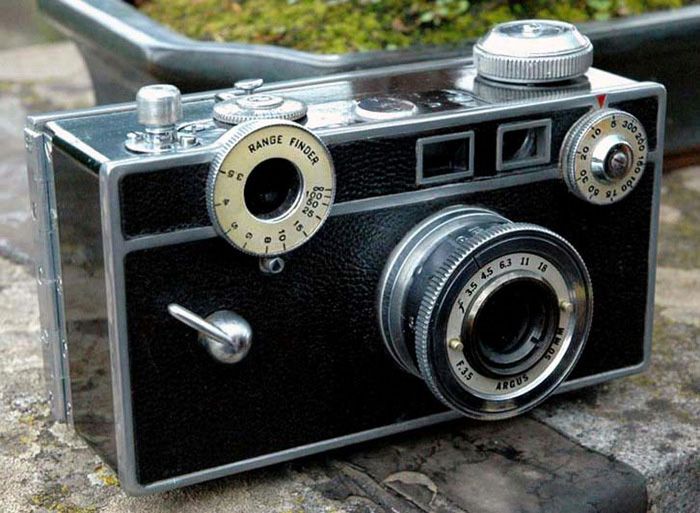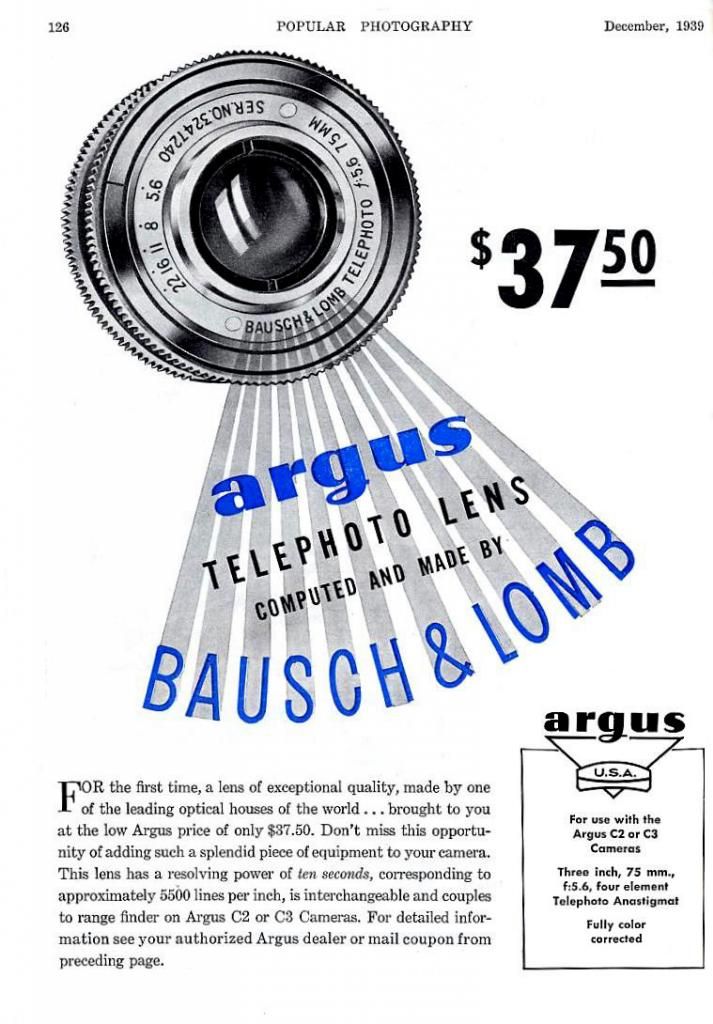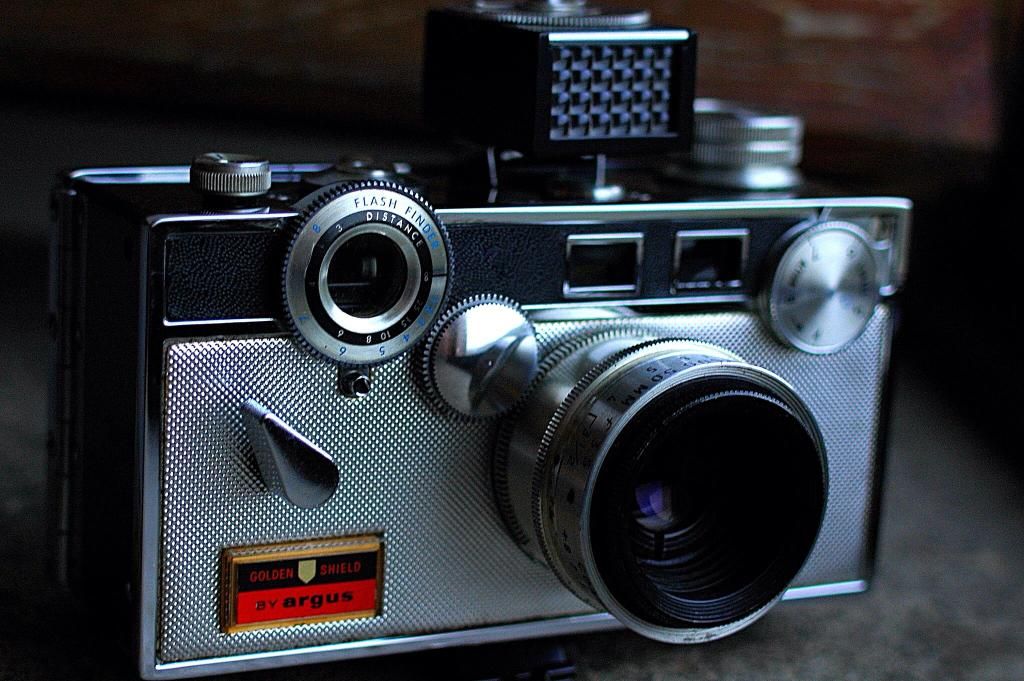mickeyobe
Lifetime Member
   Resident President
Resident President
Posts: 7,280
|
Post by mickeyobe on Nov 8, 2014 2:42:15 GMT -5
I was devastated not to see the immensely popular Brick - the Argus C3 represented herein. Its unique never before and never after shape, its sturdiness, its longevity, its annoyingly flippant shutter cocking lever and its useless focus wheel have earned it its just fame. I admit it is not by a long shot my favourite camera but I can't let my prejudice deny it its rightful place in the annals of clunkerdom mediocrity. Mickey  |
|
|
|
Post by genazzano on Nov 8, 2014 3:00:27 GMT -5
I think the ridicule that has been heaped upon the Argus C models is undeserved.  David |
|
Stephen
Lifetime Member
   Still collecting.......
Still collecting.......
Posts: 2,718
|
Post by Stephen on Nov 8, 2014 14:36:35 GMT -5
It so very odd though, almost every item in it was not designed by camera engineers but ex radio engineers...with a leaning towards Art deco design, with the look of 1930's medical equipment technology about it.
It's sturdy, but then any block shape in thick metal and bakelite would be, but every control is in the wrong place, the focusing ideas barely reach reality on the coupled rangefinder version. It must be the only camera where the case seeks to correct the design by adding rounded ends!
It's salvation was the lens, it worked fine, but was a step down from most German lenses. The engineering inside is, well, OK, but is made of absolutely standard parts, stamped out, or diecast, no adjustments required on assembly as the tolerances were loose to allow assembly by untrained staff.
Many ex-radio designers tried their hand at simplifying cameras in the States to make them easy to manufacture, using parts that unfortunately were over simplified.
If Argus had sat back and asked why the rest of the trade used more complex designs, the answer is with the other makers, they needed to be more complex and better built to deliver the goods.
The problems came with success, at first it worked fine for the price, and the sales went up, and then they tried to improve the design, but within the constraints they had blessed themselves with, leaving a classic curiosity.
Ultimately it was a long lived design, but mainly driven by cost cutting, and a low retail price.
|
|
|
|
Post by julio1fer on Nov 8, 2014 17:31:49 GMT -5
The C3 has probably the easiest-to-fix shutter of any adjustable camera, a very decent lens, and is very rugged. And it appears in the Harry Potter series, which proves it is magical. What else is needed? (and yes, an usable rangefinder would have been nice).
|
|
|
|
Post by genazzano on Nov 9, 2014 5:40:30 GMT -5
The Argus A and subsequent derivative models clearly show the influence of Art Deco radio designs. However, the C, C2, and C3 were designed by engineers led by Gustave Fassin who came from Bausch and Lomb. Fassin had been involved in optical designs related to microscopes prior to his appearance at Argus (then known as International Research Corp. or IRC) by 1938. B&L soon provided the Cintar lenses and even a special, and rather expensive telephoto lens for the C2 and C3. This B&L telephoto lens was offered at about $37.50 equivalent to about $700 in today's dollars. This at least reflected the attitude that the C2/3 models were considered to be of moderately high quality. The performance of the camera, including its odd but reliable shutter, bore this out and sales reflected this quality.  The f/3.5 Cintar coated lenses were and are today excellent performers though setting the f stops was not convenient. None the less, the setting of f stops on the C2/3 lens was not much different from the vaunted Elmar from Leitz found on most Leicas of the era. It has always been the case that any leading product in any field becomes the target for criticism and the Argus C3 was certainly a leader in the field of affordable 35mm cameras for the next decade. It can be argued that Argus stuck with that basic design too long and in the 1950's found that it was no longer competitive. However, the techno style of the exposed RF linkage continued to be attractive to the public and eventually the design became the most successful product in 35mm camera field until being eclipsed by the late 1960's. Many other successful camera designs utilized the fore finger driven focus wheel but with hidden mechanical linkage. However, the C2/3 rangefinder performed well and could easily be adjusted through a small port if the need arised. The shutter speed wheel is at odds with generally used designs but it was necessitated by the quite unique shutter design. Today after many decades most Argus C2/3 cameras still have fully operational shutters lending support to the claim that the shutter was quite adequate for the average photographer and is robust and reliable even today. I'm not sure that the brick-like shape of the camera that receives so much criticism has much to do with ergonomics per se. I have always found that the curved edges of camera bodies had more to do with esthetics rather than ergonomics. Holding a squared off C3 in the hands provided ease of operation with the rangefinder, shutter cocking lever and release button all within reach of the fore finger. Adjustment of shutter speeds and f stops on the C3 were not significantly different from those of cameras of much more complex design and cost such as the Leica IIIf. In my opinion, the Argus C2/3 cameras have attracted undue criticism largely because they are different, they were so successful and reliable that today places like Ebay are filled with examples at low prices. The low prices belie the fact that these are excellent and reliable cameras that are still capable of producing good photographs for decades to come. |
|
Stephen
Lifetime Member
   Still collecting.......
Still collecting.......
Posts: 2,718
|
Post by Stephen on Nov 9, 2014 9:25:52 GMT -5
Firstly, not meaning to offend US readers or Argus collectors,(I do have one), just reporting the attitude of the photographic trade in the UK, most shops would not buy them in secondhand, they had little or no experience of them.
When we bought them they sat in the window for years.
As never widely advertised in the UK, very few shops or buyers were aware they had interchangeable Lenses.
Not sure as the the Trade Camera list price, but one list showed the value as effectively zero, buy in at own risk. This also included most Ensign, Kodak box cameras and Bencini !! So Argos were not alone.
Maybe it is the particular lens, but mine is acceptable, but not a good as say a Vito or Sillette lens.
Never had a chance to try the other lenses, there are few in the UK, I tried in the 1970/80 period and I found none in the trade, even in London stores like Camera Exchange group.
I remember an article celebrating the Brick in Modern Photography that was read by our manager, who commented was it an April Fool joke, as he disbelieved the longevity and vast quantities sold in the States. The general opinion was that they were not serious cameras at all.
So in the end it has proved a decent design, I know this, but boy did it come in for some flack in it's day.
Stephen
|
|
Deleted
Deleted Member
Posts: 0
|
Post by Deleted on Nov 9, 2014 19:20:55 GMT -5
The C3 probably did more to introduce 35mm photography to the American masses than any other camera. Before the C3 most folks stuck to box cameras because the Leicas and Contaxes weren't something the average person could afford. Argus didn't try to market the C3 in Europe because they were smart enough to know that was a more sophisticated market. Prior to WWII few Americans had any experience with 35mm photography. The Brick was a relatively inexpensive introduction. Many who started with the C3 went on the Japanese gear with interchangeable lenses a few years later.
|
|
|
|
Post by genazzano on Nov 10, 2014 1:37:44 GMT -5
I have always been a bit curious regarding the C3's reputation. I know that a rare metric variant exists according to the Argus collectors. However, there was no significant effort to market the cameras here in Europe.
David
|
|
Stephen
Lifetime Member
   Still collecting.......
Still collecting.......
Posts: 2,718
|
Post by Stephen on Nov 10, 2014 8:37:55 GMT -5
There was a curious group of cameras that always seemed to be left after the New Years sales, having occupied the bargain bin to clear old stock, it was lead by Ensign Fulvue, Kershaw folding Cameras, the Purma, the Agilux, Bencini, Kodak box, or any box camera generally, and occasional Bricks...They were usually purchased as part of a deal, the part we did not want! My own brick was bought for a pound, with superb leather case, and the flash gun!
Of course.... now all are classic collectors items.....
Stephen
|
|
|
|
Post by genazzano on Dec 4, 2014 18:03:08 GMT -5
You gotta admit it took a special person to appreciate the Golden Shield Argus. Sort of Brick Bling... (Say that one five times)  David |
|
Stephen
Lifetime Member
   Still collecting.......
Still collecting.......
Posts: 2,718
|
Post by Stephen on Dec 6, 2014 6:36:52 GMT -5
But you have to admit it looks even more radio like, with a distinct air of Sony in the 1960's......
Stephen.
|
|
|
|
Post by genazzano on Dec 6, 2014 9:11:59 GMT -5
The odd thing about this Golden Shield model is the fact that you cannot open the front to get at the shutter, and I have tried unsuccessfully to unscrew the lens even using a pipe wrench (!!!). This model was not designed to ever be serviced. That being said, I like it. Sort of like putting lipstick on a pig, as the old saying goes.
David
|
|
|
|
Post by jimbegor on Feb 7, 2019 17:50:07 GMT -5
I have a C3 with leather case look almost new think I paid $15.00 shipped I thought it looked pretty neat only non Nikon camera that I have
|
|